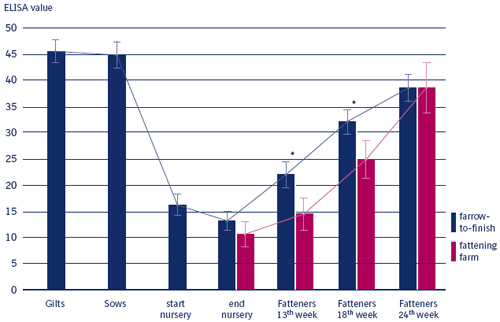2.1.5 What is the influence of the production system on the Ileitis ELISA profile?
The effect of the “production system” on the ELISA profile combines a number of different factors related to feeding, housing, animal flow and other management influences. The direct comparison of the ELISA values from farrow-to-finishing farms with specialized fattening farms revealed significant differences between the profiles (Figure 2.1.5a). Elisa values higher than 30 are regarded as positive. ELISA values between 20 and 30 are regarded as inconclusive and below 20 as negative (see for more details chapter 5.1.4).

Figure 2.1.5 a
Ileitis ELISA values in farrow-to-finishing farms compared to specialized fattening farm.
In farrow-to-finishing farms pigs seroconverted earlier and the ELISA values of fatteners between week 13 and 18 were significantly higher than in specialized fattening farms. Paradis et al. (2004) found comparable results in Canadian herds. Pigs from farrow-to-finishing farms had a significantly higher seroprevalence than pigs from specialized fattening farms. The earlier seroconversion in farrow-to-finishing farms may be influenced by differences in the sanitary measures like all in/all out which can be easier applied to specialized fattening farms. Smith et al. (1998) and Stege et al. (2001) showed that the risk of Ileitis is significantly reduced in all in/all out systems. Additionally, the common practice of strategic antibiotic treatments of the commingled pigs could contribute to the lower ELISA values in specialized fattening farms. Another likely explanation is that the sow herd in farrow-to-finishing farms forms a “carrier” state which serves as a continuous early infection reservoir for piglets (McOrist et al. 2003).
In order to account for the significant influence of the production system, the analysis of further influencing factors were done within the farrow to finish farms only.
© Boehringer Ingelheim Animal Health GmbH, 2006
All rights reserved. No part of this Technical Manual 3.0 may be reproduced or transmitted in any form or by any means, electronic or photocopy, without permission in writing from Boehringer Ingelheim Animal Health GmbH.






